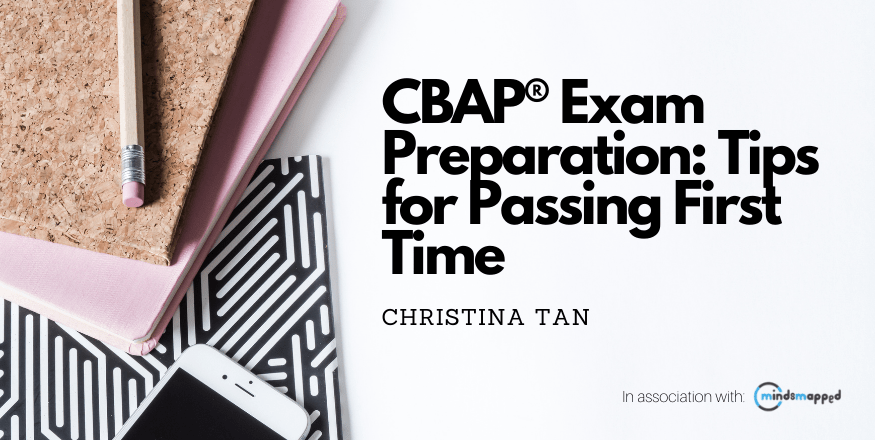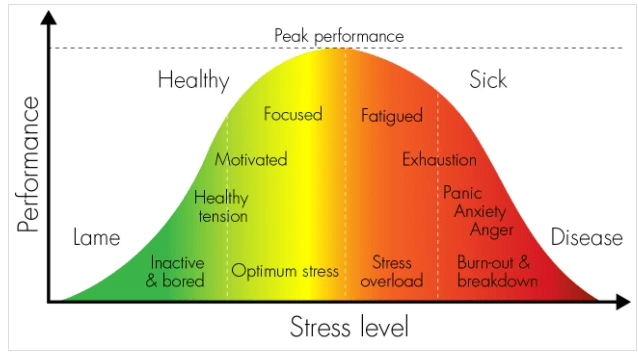
CBAP® Exam Preparation: Tips for Passing in First Attempt
How to clear CBAP Certification Exam first time
As dedicated business analysis professionals progress through their business analysis journey, there comes a point whereby they will want to validate their expertise by investing in a well-recognized professional certification. The Certified Business Analysis Professional (also known as CBAP®) offered by the International Institute of Business Analysis (IIBA) is one of the most coveted certifications in the profession, and its achievement demonstrates an individual’s application of business analysis competencies, knowledge and technique at the highest level.
For many, passing the CBAP® exam is no stroll in the park. From personal experience, I can vouch that this certification takes a significant amount of commitment and preparation. This article provides some useful tips on how to pass the CBAP® exam in your first attempt.
1. Be Familiar with the Exam Format & Basics
The things that a student will need to be familiar with from the very beginning is the IIBA exam blueprint. The first questions to ask yourself as a student when embarking on an exam preparation journey are:
Question 1: What types of questions will asked in the exam, and in what proportion?
Answer: According to IIBA’s official guidance, the CBAP® blueprint is as below.
| Knowledge Areas | Percentage Weight (%) |
| Business Analysis Planning and Monitoring | 14% |
| Elicitation and Collaboration | 12% |
| Requirements Life Cycle Management | 15% |
| Strategy Analysis | 15% |
| Requirements Analysis and Design Definition | 30% |
| Solution Evaluation | 14% |
In addition to the above IIBA guidance, there will be questions that stretches outside of the aforementioned knowledge areas so it is strongly encouraged that students do not skim on the coverage of the BABoK contents. See Point 2 below for further details.
Question 2: What marks do I need in order to pass?
Answer: Although IIBA does not explicitly state the exact pass marks, feedback from previous students indicates that the pass mark is circa 70 percent. At present, the post-exam breakdown does not include marks scored, only indicating whether the student has scored below average/average/ above average required in the respective areas.
Question 3: How long is the exam?
Answer: The exam is 3.5 hours in duration, with comfort breaks allowed during the exam (including online exams). It is important to keep track of time during the exam to ensure that sufficient time is being allocated for remaining questions.
2. BABoK Content Knowledge
The BA Book of Knowledge (also known as the BABoK) is the central text used for all of IIBA’s core BA certifications and must be studied in depth as part of the CBAP® exam preparation. This exam not only requires students to recall the correct definitions, it also provides specific scenarios in either scenario-based or case study questions. This means that, at the very least, students need to swiftly recall and apply the BABoK principles to these scenarios. The faster the factual recall via BABoK, the faster students can then apply their knowledge to the stated scenarios.
Despite the guidance provided in IIBA’s exam blueprint (see Point 1), it is strongly recommended that all CBAP® students go through the entirety of the book to master the following:
- Key Concepts:
- Elements of the Business Analysis Core Concept Model (BACCM™)
- Key Terms
- Requirements Classification Schema
- Stakeholders
- Requirement and designs
- Knowledge Areas:
- Business Analysis Planning and Monitoring
- Elicitation and Collaboration
- Requirements Life Cycle Management
- Strategy Analysis
- Requirements Analysis and Design Definition
- Solution Evaluation
- Underlying Competencies:
- Analytical Thinking and Problem Solving
- Behavioural Characteristics
- Business Knowledge
- Communication Skills
- Interaction Skills
- Tools and Technology
- Techniques: Includes but not limited to the following:
- Process mapping
- Data Modelling
- Functional Decomposition
- Interface Analysis
- User Stories
- Use Cases and Scenarios
- SWOT Analysis
Questions around techniques, competencies and stakeholder types do tend to appear in some of the scenario-based and/or case study questions and can be often be answered in a time-effectively manner for those who are sufficiently prepared. It is strongly encouraged that students cover these areas in order to maximise their marks during their exam.
3. Practice, Practice, Practice!
After all the BABoK reading, many would “feel” sufficiently confident about the exam. The next question students must ask themselves is – “Has the contents been absorbed past my short-term memory, and into long-term memory? Can I now apply the skills when given a specific scenario?”
CBAP Practice questions and mock exams provide the true litmus test for the above questions. Being able to truly understand what is being asked, under what context and aiming for precision when answering exam questions requires rounds of practice and learning from mistakes. It could well be the case that students knew the BABoK contents perfectly well but failed to understand the question, for example, if one has not considered the full context of the question, which resulted in an incorrect answer and subsequently loss of valuable marks. Alternatively, students may not have paid close attention to timings and may therefore struggle during the last hour of the exam. Without sitting through mock exams, it is difficult to gauge one’s true exam readiness. As it is much wiser to learn from your mistakes during the exam preparation stage, practicing exam questions must not be discounted in your preparation journey as being exposed to exam simulations helps to de-risk any red flags in your exam preparation journey.
As a true Business Analyst, one can say that the scores achieved from your practice stage acts effectively as your gap analysis between your ‘as is’ and ‘to be’. Fleshing out the gaps (whether it is knowledge or exam strategy-related) can help you focus on your exam preparation shortcomings and prioritise these accordingly in your revision plans.
CBAP® exam practice resources had increased in recent years, making practice questions more accessible to students. Those that tend to closely simulate the exam are IIBA’s Endorsed Education Providers (EEP). Banks of practice and mock exam questions can be obtained through IIBA’s EEP with discounts offered to IIBA members.
Now that you have completed numerous rounds of practice, you should be more at ease with proceeding to Step 4.
4. Be Honest with Yourself when Assessing Exam Readiness
After gruelling rounds of studying and practicing mock exams, the next key question to assess is your own level of exam readiness. How do you feel about your preparation to date? Are you pleased with the scores achieved in your exam simulations, or would you like more time to study or practice? Are you confident about taking the exam in the near future?
Being honest and assessing yourself on one’s readiness levels will help students decide where to turn when they have reached a critical crossroad in their exam preparation journey, and there is no shame in any answer as long as it reflects their true instincts and is also reflected as such in quantitative terms (for example, achieving consistently robust results in the practice questions). If a student had marginally passed the exam and would like some more time to brush up on a range of knowledge areas, it is possible to amend your CBAP® exam dates online up to a week before the exam.
5. Knowing when to take the Exam
Students typically schedule in an exam date to work towards, and these may be changed from time to time depending on their exam readiness levels (see Point 4). From a personal perspective, I decided to bring forward my exam as I was on the verge of ‘peak performance’ and ‘fatigue’. I had assessed my exam readiness, comfortably passed my mock exams and had covered the entire BABoK at least thrice at this stage, and any more at this stage would be counterproductive in terms of exam preparation as well as from a wellbeing perspective.
Below is an illustration of the stress level versus performance threshold.

It is important to note that threshold levels differ by individual; hopefully the above illustration encourages individuals to reflect and imagine means of perceiving stress and peak performance which they can apply to their benefit in their CBAP® journey.
Knowing Your Learning Style
One aspect that tutors may not teach all students is that individuals have a preferred learning style. Knowing what learning style makes you ‘click’ may go in a long way when it comes to preparing for exams. Knowing your learning style leads to ‘smart learning’, that is, to absorb new information optimally using the learning techniques that are best suited for you.
There are 4 common learning styles:
- Visual/ Spatial: Students under this category prefer using visual aids such as pictures, diagrams and mind maps to access and understand information.
- Auditory: Students under this category prefer listening and speaking in situations such as lectures and audiobooks.
- Read & Write: Students under this category thrive by learning through taking notes and reading.
- Kinesthetic: Students under this category are hands-on learners, for example they may attempt practice questions at an earlier stage of their learning journey.
Referred to as SWOT (“Study Without Tears”), educational theorist Neil Flemings offers strategies on how students can use their learning modalities and skills to their advantage when studying for an upcoming exam.
- Visual/Spatial SWOT Strategies:
- Utilise visual aids such as charts, graphs, and diagrams.
- Redraw any visual diagrams or notes from memory.
- Replacing important words with symbols or initials.
- Highlighting important key terms in corresponding colours.
- Auditory SWOT Strategies:
- Record your summarized notes and listen to them on tape.
- Talk it out. Discussing topics with others to expand upon your understanding of a topic.
- Repetitively read your notes and/or assignment out loud.
- Explain your notes to your peers/fellow “aural” learners.
- Read & Write SWOT Strategies
- Write, write and rewrite your words and notes.
- Reword main ideas and principles to gain a deeper understanding.
- Organise diagrams, charts, and graphic organizers into statements.
- Kinesthetic SWOT Strategies
- Use real life examples, applications and case studies in your summary to help with abstract concepts.
- Redo experiments, projects or questions.
- Utilise pictures and photographs that illustrate your idea.
Knowing your learning style helps students greatly with effective absorption and internalising of concepts and is considered a useful tool for all future learning endeavours.
Study Groups and Networking
Many professionals tend to prepare for the CBAP® exam using distance learning resources, and occasionally they may feel isolated from the lack of interaction with the wider BA community who are also taking this certification. Whilst this sentiment may not apply to all students, it is important to note that BA communities are on the increase, regionally and nationally. Local IIBA Chapters may also offer online study groups for their members so that students can learn all about BABoK chapters whilst staying connected to their peers. Alternatively, there may also be Meetup groups for Business Analysts available in your local area or LinkedIn groups who may be able to offer a listening ear and provide some practical and/or moral support.
Parting Words: Stay Focused and Prepared
The CBAP® exam is for experienced Business Analysis practitioners, and as such, the exam journey should be perceived as a marathon. As the pinnacle of the Business Analysis profession, this exam is bound to challenge the most experienced of individuals. The key is to remain focused throughout the journey and be as prepared as possible, leaving no stone unturned to maximize your chances of first-time success. Having mini-milestones in your journey and working towards planned targets and ensuring that you are confident at each step is imperative. Remember, luck favors the prepared!



